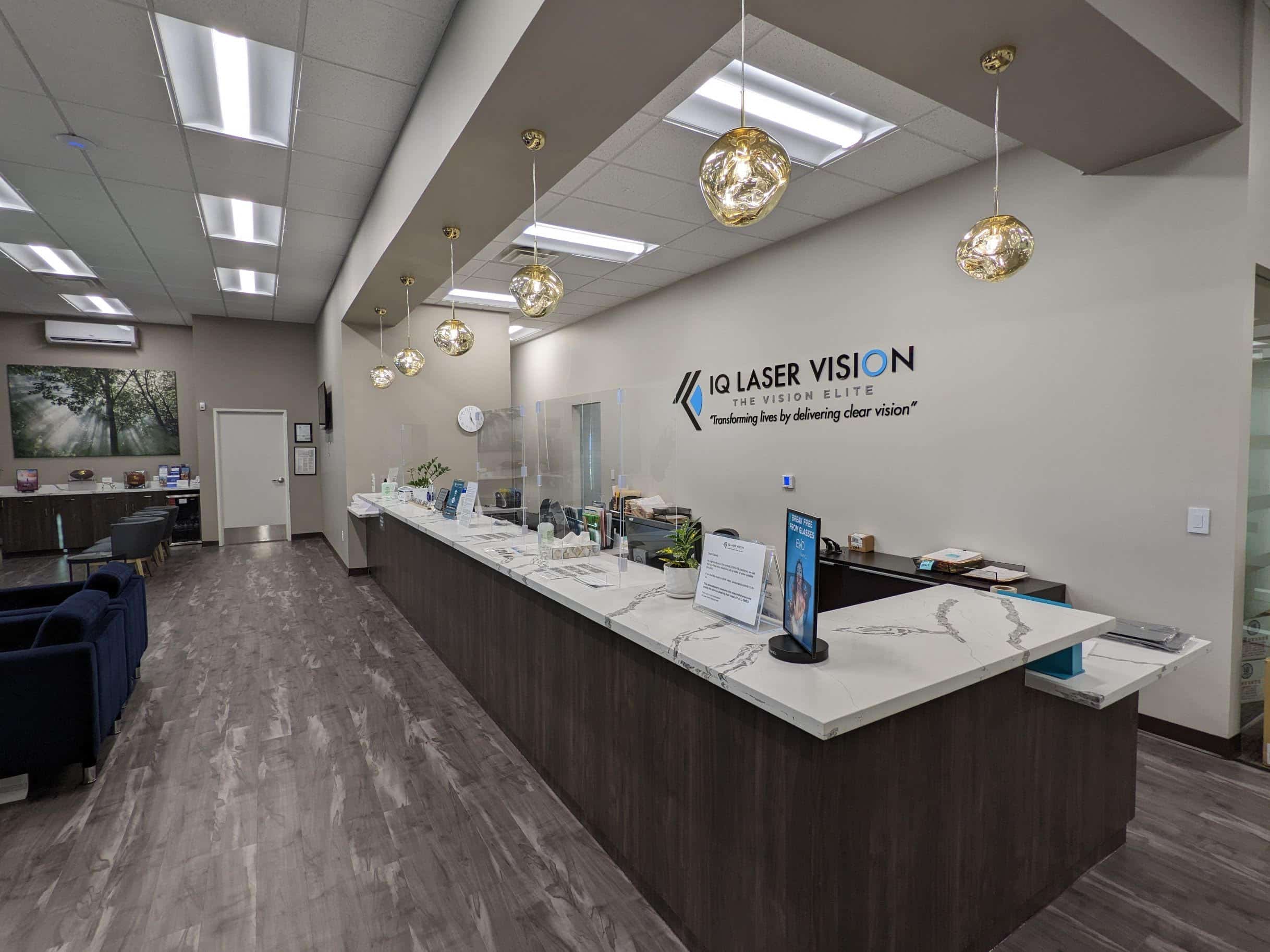
Common Vision Conditions by Age
At any age, eye care is important. But you may not know how to take care of your eyes or your child’s eyes.
We’ve broken down common vision conditions by age to help you gain a better understanding of your vision, no matter how old you are!
Children and Teens Ages 6 to 17
According to the 2016–2017 National Survey of Children’s Health, 1.6% of U.S. children from birth through 17 years suffered from blindness or had problems seeing even when they had glasses. This represents over 1.1 million children.
Refractive Errors
For many children, the problems that they have with seeing are because of refractive errors. Refractive errors include nearsightedness, farsightedness, and astigmatism.
They occur because light cannot focus on the retina properly.
Ideally, the eye is supposed to be round like a basketball. But with refractive errors, the shape of the eye changes, making it harder for light to focus on the retina and distorting how you see images.
Nearsightedness
Usually with nearsightedness, your eyeball is either longer than it should be, or the cornea is curved too much. Rather than light focusing on the retina, when you’re nearsighted, light focuses behind the retina. You can see up close clearly, but you’ll find it hard to see things that are far away at a distance.
Children and teens may be nearsighted, making it hard for them to see things at a distance like the board at school. If you’re a parent, you can pass this issue into your children.
Some children have progressive nearsightedness that will get worse as they get older. They can wear glasses or contact lenses and will likely need new prescriptions as their vision changes with age.
Farsightedness
With farsightedness, your eye will either be too short, or the cornea isn’t curved enough. This will make it harder to see things that are up close and right in front of you.
This will make your up-close vision blurry. Children that are farsighted will usually wear glasses or contacts to correct their vision.
They may wear their glasses when they need them for close-up activities, like completing a puzzle or doing their homework for school.
Astigmatism

If you have astigmatism, your cornea or lens is curved more steeply in one direction than in another direction. When you have astigmatism, light can’t enter the eye correctly, which makes your vision blurry.
Instead of the cornea being round like a basketball, with astigmatism, your cornea has a shape that’s more like a football. If you have astigmatism, you’ll have blurry vision when looking at things that are both up close and far away.
You can have more than one refractive error, so it’s common to have another refractive error with astigmatism, like nearsightedness or farsightedness. Children with astigmatism may have it in one or both of their eyes.
Wearing glasses or contacts can help children see better with astigmatism, and some children may even grow out of astigmatism as their eyes continue developing!
As your children’s eyes are still growing and developing, they can’t have any surgical procedures to correct refractive errors. Wearing glasses or contacts are the best solution for treating these until their eyes are stable!
Orthokeratology
Orthokeratology (Ortho-K CRT) is a prescription contact lens that is like orthodontics but for your eyes! For children who are usually nearsighted, orthokeratology is a surgery-free way to correct their vision.
Children wear this contact lens while they sleep. The lens reshapes the cornea at night, providing temporary vision improvement.
This works by flattening the center of the cornea and changes how light bends as it enters the eye. Your child then takes the contact lens out in the morning. The eye stays in the new shape all day, reducing nearsightedness and leaving their vision improved without needing to wear glasses during the day.
To keep the vision correction results from orthokeratology, your child will need to wear the lenses as long as their doctor has recommended it. Once these have been achieved, your child will wear a retainer lens to maintain their corrected vision.
Eye care for children
Children should start having annual comprehensive eye exams when they begin pre-school. These appointments will help your eye doctor diagnose and treat problems early.
If you notice your child struggling in school, it could be because they are having issues seeing. Children that have problems with reading or their behavior in school can often be due to untreated vision issues.
You may be familiar with wearing eye protection as an adult, but children should wear eye protection as well! If your kids play sports, make sure they wear protective glasses to reduce any eye injuries.
Don’t forget to protect their eyes when they are outdoors as well. Buy them sunglasses that provide protection from the sun’s rays and have them wear them anytime they play outside. It’s never too early to teach your kids good eye care!
Adults Ages 18-40

Once you are around the age of 18, your eyes will stop growing. 91% of people over 18 years of age have a stable prescription. If you’ve ever thought about vision correction procedures that will allow you to see without glasses or contacts, this is the perfect time!
Treating vision issues now will improve your vision and quality of life as you get older. Your eyes are healthiest right now and will also heal the fastest after any kind of procedure!
LASIK
People with nearsightedness, farsightedness, or astigmatism may qualify for LASIK. LASIK is the most popular elective procedure you can have.
At IQ Laser Vision , our patients report a 99% satisfaction rate with their results! What’s not to love about permanently clear vision that’s yours to enjoy?
LASIK is not for everyone but for those that qualify, lasers are used to reshape your cornea and correct your vision. There’s a good chance that after LASIK, you’ll have 20/20 vision or better!
IQ Laser Vision pioneered a method of LASIK known as All Laser Soft Touch Comfort Micro-LASIK® which creates an ultra-thin corneal flap. With this exclusive method, our patients have fewer issues with dry eyes than with other LASIK procedures.
If you have been told that you can’t get LASIK because you have thin corneas, you may be able to undergo this method! Why not schedule a LASIK consultation at IQ Laser Vision right now to find out if you can have LASIK?
EVO ICL
Another popular procedure for vision correction is having the Visian ICL. This is especially beneficial for people that are severely nearsighted.
The Visian ICL is a tiny lens implant that provides you with freedom from glasses and contacts while improving your vision. The best part is it’s removable if you change your mind!
PRK or LASEK
Have you been told that LASIK isn’t right for you, but you still want to achieve visual freedom? PRK is a procedure that’s a lot like LASIK but there’s no flap created on the cornea.
If you have thinner than average corneas, this could be the procedure that finally makes vision correction possible for you. During LASEK, lasers move the epithelium to the side during treatment before they move it back, which is less invasive.
SMILE
Another vision correction procedure you may want to consider is SMILE. No, SMILE is not for your teeth but for your eyes! With SMILE, you’ll achieve permanent vision correction like LASIK.
One key difference between these two procedures is there’s no flap created during SMILE. Instead, there’s a tiny incision that’s only about 4 millimeters in length created during this procedure.
This is especially significant if you’re someone who already has dry eye syndrome and may not be a good candidate for LASIK. With a smaller incision, this means most patients that have SMILE don’t end up with dry eye symptoms after.
SMILE is often a better choice if you’ve already found out that you don’t qualify for LASIK. Why not schedule a SMILE consultation at IQ Laser Vision now?
Eye care for adults 18-40 years old
To make sure your eyes are healthy, you should continue getting regular eye exams. If you don’t have any refractive errors, you can get an eye exam every 1-2 years.
If you have refractive errors and wear glasses or contacts, you should see your eye doctor every year. This will make sure your prescription is up to date.
Eye exams will allow your IQ Laser Vision ophthalmologist to check your eyes are healthy.
Adults Ages 40-60 years old

As you get older, you may find it harder to see or focus on things with ease. Reading the Sunday newspaper may become much harder than it used to be!
It’s not your imagination, but you could be developing a vision problem called presbyopia, or age-related farsightedness.
Presbyopia
Presbyopia is age-related farsightedness. With presbyopia, the lens of your eye will become less flexible.
You’ll find that focusing on things that are right in front of you is much harder. This could be your smartphone when you’re texting, trying to read a book for your book club, or knitting a blanket for your granddaughter.
The most common solution to this is for people to start wearing reading glasses, which can make it easier to focus on things that are up close. We can treat presbyopia with blended vision as well.
Glaucoma
It’s likely that you’ve heard of glaucoma, but you may not know what it is. Glaucoma is a condition that occurs when pressure in your eyes gets too high, leading to progressive optic nerve damage.
There are very few symptoms associated with having glaucoma so your best bet to staying ahead of it is to always see your eye doctor for scheduled eye exams. Your eye exams allow your eye doctor to measure how high the pressure in your eyes is.
If glaucoma is left untreated, it will lead to irreversible vision loss.
Age-Related Macular Degeneration
If you are over the age of 50, you are more likely to develop age-related macular degeneration. This disease affects the inside back layer of the retina.
It can make everything look distorted or create blind spots in the middle of your vision.
Eye care for adults 40-60 years old
If you are between 40 and 60, you should continue having eye exams every 1-2 years. If you wear glasses or contacts, you should go every year to keep your prescription up to date.
If you notice any sudden changes to your vision, see your eye doctor to rule out any concerning issues. Any sudden changes to your vision are something you should always have checked out.
People who are 60 and older

If you’re over the age of 60, you’re at an age where you’re likely to start developing lasting age-related vision problems. You may have already had LASIK when you were younger.
If you’re thinking about vision correction, you may want to talk to your eye doctor about procedure like refractive lens exchange or cataract surgery.
Cataracts and Cataract Surgery
You’re almost guaranteed to develop cataracts if you’re over 60 years old. Common signs of cataracts include blurry vision, seeing colors as dull or faded, and cloudy vision.
Cataracts usually happen as a result of age when proteins in the lens break down and clump together, causing cloudiness. This will make your vision foggy and distorted. If you ever feel like you’re looking through a dirty window, this is a classic sign of having cataracts!
Your eye doctor will likely recommend cataract surgery if your cataracts have started interrupting your daily life. The surgery is the only way to regain clear vision lost when your cataracts developed!
There’s nothing to worry about during cataract surgery, as it’s one of the most commonly performed procedures. Your cataract surgeon will break up the cataract and remove the lens before replacing it with an artificial lens. There are many artificial lenses, known as IOLs, to choose from, so talk over your decision beforehand with your eye doctor at IQ Laser Vision to get their recommendation.
Eye care for adults 60 years old and over
You may see blurriness or halos around lights because of medications if you’re over the age of 60. Read through the side effects of any medications you’re taking and talk to your doctor if you’re concerned your medications are affecting your sight.
Due to the risk of eye conditions, if you’re 60 or older, you should be seeing your eye doctor every year for a comprehensive eye exam.























